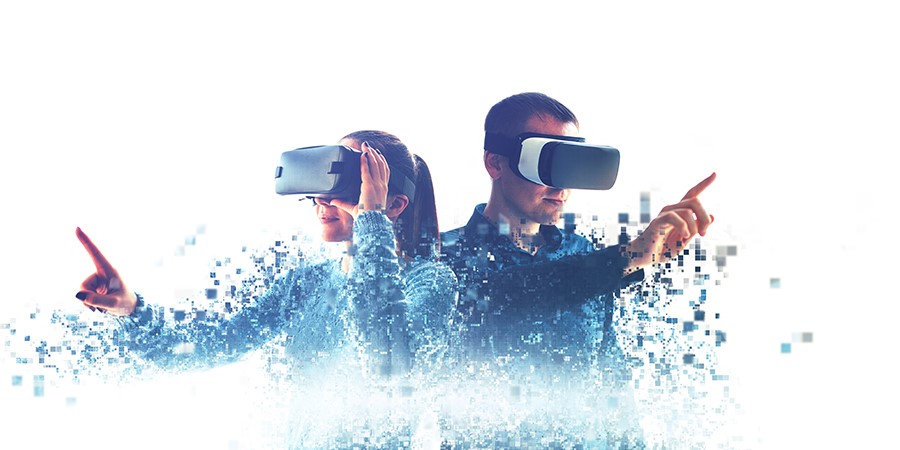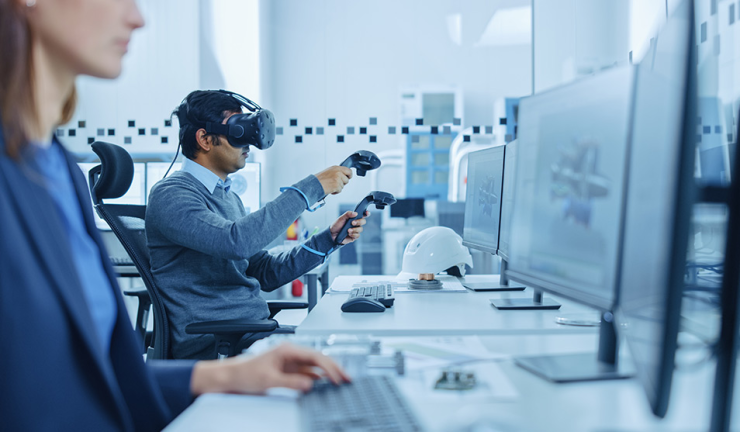Virtual Reality (VR) and Augmented Reality (AR) are undeniably at the forefront of technological innovation, and their impact on businesses across various sectors cannot be overstated. These transformative technologies are reshaping the way companies operate, connect with their customers, and achieve their objectives. While still in their developmental stages, it’s projected that both AR and VR will exceed 100 million users worldwide by 2027, indicating their significant potential.
Although the full extent of their capabilities remains largely uncharted, the statistics are a clear indicator that organizations embracing AR and VR app development services to create immersive experiences for their users are poised for success in the future.
From healthcare to travel and hospitality, AR and VR are becoming pivotal players in nearly every major industry, introducing groundbreaking applications that redefine the way we interact with technology. Whether you’re a business owner, an entrepreneur, a marketer, or simply someone intrigued by the future of AR VR development services, this guide aims to provide insights into how these technologies are currently supporting businesses in 2024.
In this blog, we will delve deeper into the world of AR and VR technology to uncover their roles in today’s business landscape. So, without further ado, let’s embark on this exploration!
What is AR and VR?

Augmented Reality (AR) and Virtual Reality (VR) are two distinct yet interconnected technologies that seek to enhance the way users perceive and interact with the digital world. AR vs. VR technologies differ in terms of the devices used and the nature of the experience they offer.
AR (Augmented Reality):
AR overlays digital information such as images, videos, and 3D models onto the real-world environment. It typically relies on devices like smartphones, tablets, or specialized AR glasses to display digital content in real-time. AR enriches the user’s perception of the physical world by adding virtual elements to it, allowing users to interact with digital objects while remaining aware of their surroundings. AR has a wide range of applications across industries such as gaming, education, retail, healthcare, and more.
VR (Virtual Reality):
VR immerses users in a fully simulated digital environment that can be entirely distinct from the physical world. Users wear VR headsets that transport them to a virtual world where they can interact with their surroundings. VR aims to create a sense of presence and immersion, making users feel like they are inside the virtual environment. This technology has diverse applications, including gaming, training simulations, architectural visualization, and therapeutic experiences.
Overview of AR and VR Technology:

Both AR and VR are encompassed within the world of immersive technology, often referred to as XR or Extended Reality. XR includes various degrees of blending the digital and physical worlds, with AR and VR representing two ends of the spectrum.
In addition to AR and VR, there’s also Mixed Reality (MR), which combines elements of both AR and VR. MR bridges the gap between the physical and digital realms, enabling physical and digital objects to coexist and interact in real time. MR experiences are characterized by the seamless integration of virtual and real-world elements.
These immersive technologies, whether AR, VR, or MR, offer unique capabilities that hold immense potential for businesses across industries. They are reshaping the way companies engage with customers, train employees, design products, and deliver services, opening up exciting possibilities for innovation and growth. Software development companies in USA have adapted by customizing AR and VR applications to meet specific industry needs, developing sophisticated simulations and intuitive interfaces.
How AR and VR Technologies Are Supporting Businesses in 2024?

In 2024, Augmented Reality (AR) and Virtual Reality (VR) technologies are offering substantial support to businesses in various ways. One of the notable ways is by enabling interactive and informative data visualizations. These technologies provide a unique platform for businesses to unlock meaningful insights from complex data by presenting it in an immersive and engaging environment.
By using AR and VR for data visualization, businesses are not only making their data more accessible but also elevating their capacity for data-driven insights and decision-making. As these technologies continue to advance, their role in supporting businesses in 2024 and beyond is likely to expand even further across diverse industries.
AR and VR tools facilitate the transformation of static charts and spreadsheets into dynamic, 3D representations. Users can interact with data points, explore trends, and gain a deeper understanding of information that might be challenging to grasp through traditional methods. This capability is particularly valuable in industries such as finance, analytics, and research, where data-driven decision-making is paramount.
Here are some ways AR and VR data visualization are currently supporting businesses in 2024:

1. Enhanced Data Exploration
AR and VR allow users to immerse themselves in data environments, making it easier to explore datasets from different angles and perspectives. This promotes a more intuitive and insightful understanding of complex data structures.
2. Collaborative Analysis
Teams can collaborate within shared virtual spaces, making data analysis a collaborative and interactive process. Multiple users can simultaneously manipulate data visualizations, fostering teamwork and real-time decision-making.
3. Training and Education
Businesses can leverage AR and VR for data-related training and education. Employees can interact with data simulations, improving their data literacy and analytical skills.
4. Customer Engagement
AR and VR data visualizations can be used in presentations and marketing materials to engage customers and stakeholders more effectively. Interactive visualizations can help convey complex information in a compelling manner.
5. Risk Assessment
In industries like finance and insurance, AR and VR can simulate various scenarios based on data inputs, aiding in risk assessment and decision-making.
6. Product Development
AR and VR enable product designers and engineers to visualize data related to prototypes and designs in a virtual environment, facilitating real-time collaboration and iteration.
7. Healthcare
Medical professionals can use AR and VR to visualize patient data, such as 3D scans, in a more immersive manner, improving diagnostics and treatment planning.
AR and VR Emerging Trends in 2024 that are Reshaping Businesses
As AR and VR continue to evolve, their impact on businesses across industries becomes increasingly profound. Embracing these trends can lead to enhanced training, marketing, customer service, and innovation, ultimately providing a competitive edge in the rapidly changing business landscape. If you’re considering implementing AR and VR technology in your business operations, collaborating with experts in AR/VR development services can help bring your ideas to life.
Immersive Experiences:
VR technology allows users to be transported to entirely new virtual worlds, enabling them to interact with virtual objects as if they were physically present. This immersive capability is no longer limited to gaming and is now revolutionizing various business operations.
Tailored Training:
AR and VR are ushering in a new era of personalized training experiences. Businesses can provide tailored training to employees, simulating real-world scenarios and offering hands-on experiences in a safe and controlled virtual environment. This is particularly valuable in industries such as machinery, healthcare, and aviation.
Remote Teamwork:
Physical proximity is no longer a necessity for effective teamwork. AR and VR technologies enable geographically dispersed teams to collaborate in shared virtual environments. This facilitates virtual project meetings, brainstorming sessions, and training workshops, enhancing collaboration across the globe.
Virtual Events:
AR and VR are transforming how businesses host events. Virtual spaces are now used to organize immersive and memorable events, allowing attendees to participate from the comfort of their homes. Virtual events eliminate the need for travel, accommodations, and venue capacity concerns.
Product Design:
Traditional methods of product design often rely on 2D renderings and sketches. AR and VR technology provide businesses with a better understanding of their products by allowing for interactive 3D modeling and design in a virtual environment. Designers, engineers, and stakeholders can collaborate in real time within a shared digital space.
Marketing Transformation:
AR and VR are revolutionizing marketing strategies by offering interactive and immersive campaigns. Businesses can engage customers with 3D virtual showrooms and interactive marketing materials, turning passive observers into active participants.
Enhanced Customer Service:
AR and VR extend the boundaries of customer service beyond traditional methods. Virtual assistants can guide users through complex processes, demonstrate product features, and troubleshoot issues in real time, enhancing the customer experience.
Data Visualization:
Traditional data visualization methods can be static and less engaging. AR and VR technologies are elevating data visualization by creating interactive and immersive data environments. Users can dive deep into complex datasets, making it easier to understand and analyze information.
Accessibility:
AR and VR are breaking down physical barriers, making business experiences more inclusive. These technologies offer solutions for people with disabilities, providing immersive experiences and accessible virtual environments. Gestures and voice commands make content interaction more intuitive.
Manufacturing Innovation:
AR and VR have the potential to revolutionize manufacturing processes. Businesses can visualize, simulate, and optimize product designs with precision before physical production begins. Virtual prototyping and testing in various scenarios help identify flaws and refine designs, reducing errors and costs.





